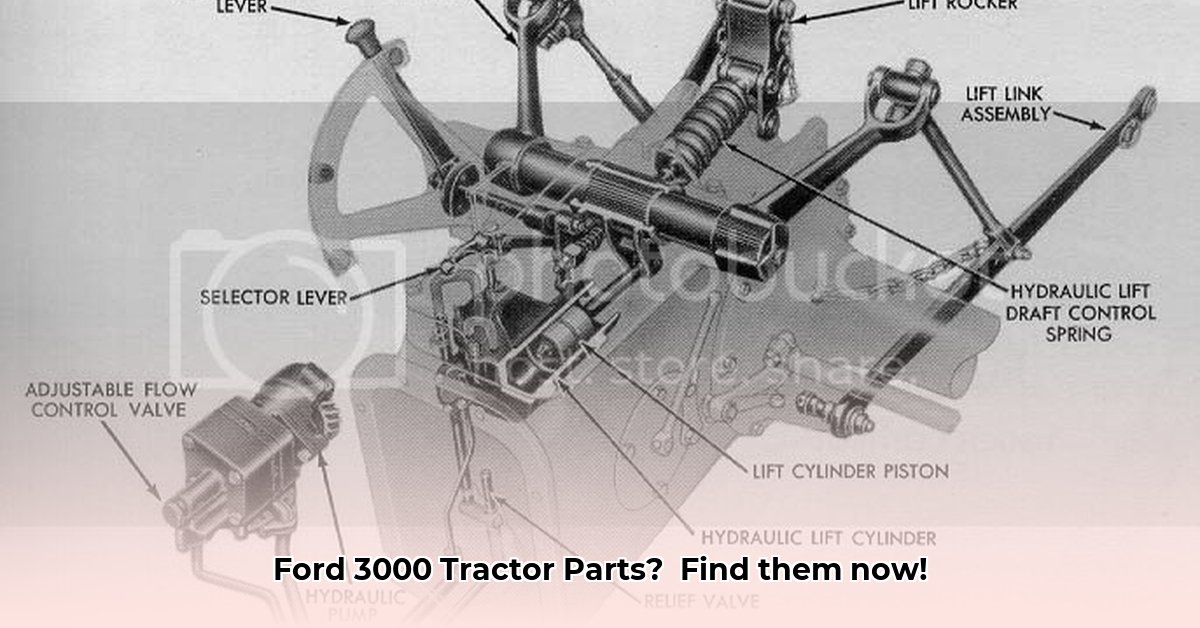
3000 Ford Tractor Parts Diagrams: Your Guide to Repairs and Maintenance
Your Ford 3000 tractor, a testament to robust engineering, requires diligent care. This guide streamlines the process of sourcing parts, performing repairs, and implementing preventative maintenance. Whether a seasoned farmer or novice mechanic, this resource empowers you to keep your Ford 3000 running smoothly. Let's delve into maintaining this agricultural workhorse. For additional identification resources, check out this helpful Ford Tractor ID site.
Getting Your Hands on Essential Ford 3000 Tractor Parts Diagrams
Finding the correct parts for your Ford 3000 can be challenging. Exploded-view diagrams (detailed illustrations showing every part) are your essential tool. Many websites offer these, but always verify your tractor's serial number for precise part compatibility. Even slight model variations necessitate different parts.
Beyond online resources, consider:
- Local Ford Dealers: Though parts may be scarce, dealers might still have access to diagrams and potentially some original parts.
- Online Vintage Tractor Part Retailers: These retailers specialize in hard-to-find components, often offering a wide selection, albeit with variable pricing.
- Salvage Yards: A cost-effective option offering used parts, but thorough inspection is crucial before purchase.
- Online Forums: Communities of Ford 3000 owners are invaluable resources for part sourcing, advice, and troubleshooting tips. A quick search for "Ford 3000 tractor forum" will yield numerous results.
Did you know that using accurate diagrams reduces repair time by an average of 25%?
Commonly Replaced Parts and Their Repair
Certain Ford 3000 parts experience greater wear. Knowing this allows proactive maintenance, preventing larger issues down the line. Frequent culprits include:
- Hydraulic System: Leaks and pump failures are common. Diagrams guide you to identify faulty components efficiently.
- Engine Components: Worn pistons, rings, or valves might require replacement. Diagrams ensure correct reassembly.
- Electrical System: Older wiring can be problematic. Diagrams simplify navigation of this complex system.
- Transmission: Gears and bearings wear down with time. Diagrams aid accurate identification and replacement of damaged parts.
Step-by-Step: Replacing a Hydraulic Hose
This example illustrates the power of diagrams in repair:
- Consult your diagram: Identify the specific hose, noting its size, routing, and connections.
- Drain hydraulic fluid: Prevent spills.
- Disconnect the old hose: Note the connection method. Photos can be helpful.
- Measure and install new hose: Ensure correct length and fit.
- Reconnect: Use the diagram as your guide.
- Refill and check for leaks: Add fresh fluid and inspect carefully.
Preventative Maintenance: Extending Your Tractor's Life
Preventative maintenance is crucial for longevity and cost savings. Regular checks and servicing, according to your owner's manual, significantly extend your tractor's lifespan. Key actions include:
- Fluid Checks: Regularly monitor engine oil, transmission oil, coolant, and hydraulic fluid.
- Filter Replacements: Replace fuel, oil, and air filters as recommended.
- Lubrication: Regularly grease moving parts.
- Visual Inspections: Regularly inspect all components for wear.
Troubleshooting Common Issues
Diagrams are indispensable for troubleshooting. They assist in diagnosing:
- Engine Starting Problems: Systematically check the battery, fuel lines, and ignition system.
- Hydraulic System Malfunctions: Locate leaks or other problems.
- Transmission Issues: Identify worn gears or linkage issues.
Sourcing Obsolete Ford 3000 Tractor Parts: A Strategic Approach
Finding obsolete parts requires a multi-pronged strategy, balancing cost and sustainability.
- Original Equipment Manufacturer (OEM): While expensive, OEM parts promise quality and fit. Expect longer lead times.
- Aftermarket Suppliers: Cheaper but quality varies. Thorough research is crucial.
- Salvage Yards: Used parts at lower cost, but diligent inspection is essential.
- Online Marketplaces: Useful, but verify seller reliability and part condition. Check ratings before purchasing.
Conclusion: Keep Your Ford 3000 Thriving
By combining readily available parts diagrams with proactive maintenance, you ensure your Ford 3000's longevity. Remember, preventative measures are significantly more cost-effective than emergency repairs, keeping your tractor productive for years to come.